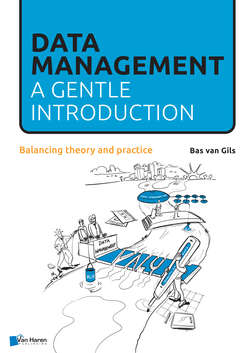Читать книгу Data Management: a gentle introduction - Bas van Gils - Страница 27
На сайте Литреса книга снята с продажи.
■ 7.1 INTRODUCTION
ОглавлениеIn chapter 2, I discussed how many organizations see data as one of their most important assets. A loose definition of DM therefore is: the capability that the organizations have in order to manage data as an asset. While this gives a good idea of the purpose of DM, it doesn’t say much about what it entails to do DM. The definition from the DMBOK gives a bit more insight [Hen17]:
Data management is the development, execution, and supervision of plans, policies, pro- grams and practices that deliver, control, protect and enhance the value of data and information throughout their lifecycles.
In a recent article about data strategy, already mentioned in section 3.2, this was compared to the world of sports such as soccer or ice hockey [DD17]. The purpose of DM is twofold:
• Grip on data - This is what the first part of the DMBOK definition talks about. This part of the definition gives an overview of the types of activities that are involved in DM: the idea is to determine what we want to do with data (plans) and set up policies and practices (guard rails) to steer the organization in the right direction. This direction entails, on the one hand, the delivery of data to turn it into value but also how the controlling, protection, and enhancement of data assets can make that happen. A big task indeed.
• Value creation through the use of data - The latter part of the DMBOK definition suggests that the purpose of DM is to turn data into value throughout its lifecycle. After its creation it can be used and reused in processes until eventually the data gets archived or destroyed.
The analogy from example 14 clarifies these two perspectives further.
Example 14. The data river
In this example, I will compare water that flows through a river to data that flows through an organization. The example is illustrated below:
Consider a river that starts in the mountains. Assuming that high up the mountains there is little or no pollution, the water is expected to be clean. This is the equivalent of data that gets created in a process and stored in a system. As a rule, data tends to be correct/ or high quality here too.
When the water starts flowing down the mountain it passes a few villages where people use it for various purposes: drinking water, shower, and perhaps it is used by a local factory in its production process, polluting the water somewhat. As long as the factories are downstream, most of the upstream citizens won’t mind too much. This is the equivalent of data that “moves” through the organization, from system to system, to be used in various processes. There is a high risk of introducing “pollution” in the form of problems with the data quality. Here too, if you are upstream then the problems with data quality from downstream won’t affect you too much.
The water keeps flowing and a bit downstream there is a big dam and power plant. Here the speed of the flow of water is controlled and it is used to generate power for local towns. After the dam, the river forks. One of the streams flows into a water cleaning facility after which it continues on to the next village. The other end flows to what used to be a cool beach but is now deserted because of the polluted water. This is called data movement and techniques related to it stem from an area called data integration. The equivalent of the dam/ power plant is a system that controls the flow of data. After that comes the fork in the data river. In one data stream there is a data quality solution that cleanses the data making it usable for local users. In the other stream there is no such solution.
Last but not least, police boats have started patrolling the river to make sure no other illegal dumps of waste take place. The equivalent of the police boat is a governance structure where data management professionals check for misuse of data or prevent the introduction of errors into the data.
Note how, in both cases, the emphasis is on flow. Note also, that a local solution (e.g. cleaning water/ data) helps in one point but not in the other – it may be a better idea to fix issues upstream. Note also that in both cases, governance structures are in place to make sure things run smoothly. In both cases, the point is to make sure that certain things are in place (“grip”) such that value can be derived from the asset, be it water or data. The comparison can probably be extended further but this gives a fair indication of how water and data are similar.
The analogy of the data river was invented by Luuk Spronk-van Lieshout and Emine Ozturk, two data stewards at PGGM – a Dutch pension provider.
In this book, I will take the point of view that DM is an organizational capability. The capability of the organization depends on certain resources (people, systems) being in place. These resources together make sure that there is enough grip on data and enable the organization to use data and get value from its data assets.
